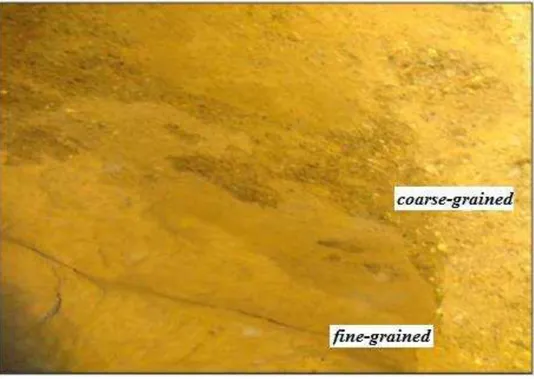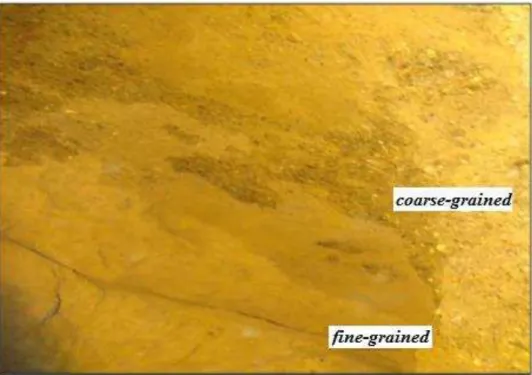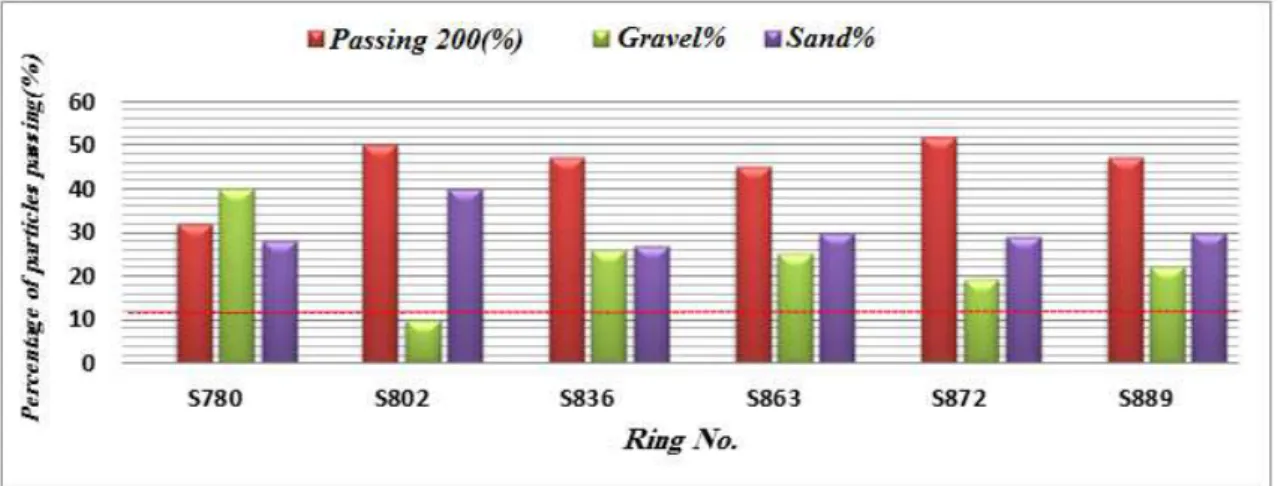IJMGE
Int. J. Min. & Geo-Eng.
Vol.50, No.1, June 2016, pp.23-36.
Geological Hazards analysis in Urban Tunneling by EPB Machine
(Case study: Tehran subway line 7 tunnel)
Hasan Bakhshandeh Amnieh
1*, Mohammad Saber Zamzam
2and M.R. Mozdianfard
31. School of Mining, College of Engineering, University of Tehran, Iran
2. Department of Mining Engineering, University of Kashan, Iran
3. Department of Chemical Engineering. University of Kashan, Iran
* Corresponding Author Email: hbakhshandeh@ut.ac.ir, Phone, fax: +98-21-88008838
Abstract
Technological progress in tunneling has led to modern and efficient tunneling methods in vast underground spaces even under inappropriate geological conditions. Identification and access to appropriate and sufficient geological hazard data are key elements to successful construction of underground structures. Choice of the method, excavation machine, and prediction of suitable solutions to overcome undesirable conditions depend on geological studies and hazard analysis. Identifying and investigating the ground hazards in excavating urban tunnels by an EPB machine could augment the strategy for improving soil conditions during excavation operations. In this paper, challenges such as geological hazards, abrasion of the machine cutting tools, clogging around these tools and inside the chamber, diverse work front, severe water level fluctuations, existence of water, and fine-grained particles in the route were recognized in a study of Tehran subway line 7, for which solutions such as low speed boring, regular cutter head checks, application of soil improving agents, and appropriate grouting were presented and discussed. Due to the presence of fine particles in the route, foam employment was suggested as the optimum strategy where no filler is needed.
Keywords: EPB, geological hazards, mechanized tunneling, Tehran subway line 7.
1. Introduction
Design of underground structures, such as subway tunnels, is different to that of other
surface structures due to unknown
geotechnical and geological conditions and variations experienced in each project, where construction risks cannot be precisely defined due to uncertainties in their corresponding engineering modeling [1, 2]. Hence,
construction methods need to be continually conformed to the ground conditions, while setting up a safety management system with a higher sensitivity [3, 4, 5].
Geological hazard associated with the tunnel route is an important parameter in selecting the route, type and specifications of the excavation machine, as well as the
throughout the tunnel route, geological hazards are varied in content and mechanisms. In the mechanized urban tunneling projects, two important parameters, which could be used as criterial operational effectiveness, are considered [4, 8, 9]; a) safety and controlled ground subsidence, b) progress rate.
The former refers to avoiding damages to buildings, streets, and other such surface infrastructures [10], while the latter refers to cost and time efficiency, keeping in mind the former. Hence, quantitative and qualitative parameters are defined to evaluate the operational circumstances and improve its efficiency [10, 11]. However, in evaluating the risks and simultaneous timely response to them, mitigating circumstances are often imposed due to financial, technical, and time constraints [4, 11, 12]. Prioritizing the hazards before start-up and reviewing them while
through Mahallati highway and Mohammadieh sq., it changes course south-northerly along Navvab highway, under the 6-band dual-way Tohid tunnel, and alongside the 435 m Milad tower. Its final station is at Boostan sq. in Saadat Abad, north-west of Tehran [16].
Geotechnical studies have been carried out on 2 sections (north-south and east-west) of this line in 3 conceptual, preliminary, and final phases. Field data were collected wherever possible in the preliminary phase using 29 boreholes and 11 test pits along the route based on the presented guidelines and technical specifications [17].
The tunnel route ground layer was divided into 6 separate engineering geology units (referred here as ET) and studied as reported in Tale 1.
Table 1. Engineering specifications of geological units [17]
Geological
Units (ETs) ET-1 ET-2 ET-3 ET-4 ET-5 ET-6
soil characteristics
sandy gravel and gravelly
sand
coarse soil of gravelly sand with silt and
clay
clayey sand with gravel
coarse soil of clayey sand
with gravel
clayey silt and silt clay
with some sand
sandy silt
% passing sieve No. 200
(silt & clay)
3 to 12% 12 to 30% 30 to 60% 22 to 34% > 60% > 60%
soil type (USCS)
GW, GW-GM, GP-GC
SW & SP
SC, SC-SM, & GC
SC, SM &
CL SC, SM
CL, ML &
CL-ML ML
Particles forming ET-6 are primarily sandy silt and similar to those at ET-5 and ET-3 as far as their size is concerned. However, considering their weak mechanical characteristics, they were classified separately here [17].
Depending on the soil layers observed at the tunnel face, the route was divided into 40 geological-geotechnical zones, based on
geological surveys’ results [17].
Fig. 3. Geological profile of tunnel route for Tehran subway line 7 [17]
3. Geological hazards identification during construction
In any tunneling project, geological hazards arise mainly from unknown nature of ground and could influence construction progress and boring machine operation. In Tehran subway line 7 project, these hazards include cutting tools abrasion and erosion, clogging, mixed face, high soil permeability, lack of fine soil particles, boulders and large rock pieces, aqueducts, and considerable change in water level along the tunnel path, which are discussed here in more details.
3.1. Abrasion and Erosion
Abrasion and erosion of cutting tools and other parts of the boring machine is influenced
primarily by the type of tunnel rock and soil. High rate abrasion, i.e. rapid and considerable consumption of cutting tools, reduces the excavation efficiency noticeably and leads to unavoidable long delays when replacing the worn parts.
particles, Quartz percentage or other abrading minerals, and particle size analysis. In these methods, application of standard parameters of soil or rock is often preferred as opposed to employing special laboratory apparatus capable of analyzing the abrasion rate [18, 19]. In this project, the geological unit ET-1 has a high abrasion potential due to the presence of coarse-grained soils (i.e. fine-grains of less than %12). About 3500 m of the tunnel route (almost 30%) lies in soils with high abrasion potentials. In the east-west part of the route (from Takhti Stadium to Mahallati-Afsarieh cross-section), there are sharp-pointed rubbles with high abrasion potentials that could easily cause extensive damages to the cutter heads and tools [17]. Maintenance reports to-date indicate that coarse-grained, sharp-pointed soils are the main cause for abrasion of boring tools, machine body, and the associated screw conveyor belts, which has led to frequent
interruptions and delays in discharge process. At distance range of 1152-1367m, which lies in the geological unit ET-2, the particle size range of coarse-grained soils (Fig. 4 and Table 1) indicates layers made with sand gravel of silt and clay with an average of 30% fine-grained materials.
In this study, percentage of sand and gravel in the soil particle size analysis was selected as a criterion for abrasion evaluation. Accordingly, the machine erosion and abrasion are also estimated by the iron filings in the soil specimens. Results are presented in Fig. and 6, where increase in soil filings is directly proportionate to the percentage of fine grains (i.e. particles passing through sieve No. 200 mesh), indicating an increase in the abrasion of machine and cutting tools.
A template was designed and fabricated as illustrated in Fig. to measure abrasion and erosion of the cutting tools.
Fig. 4. Soil Particle size analysis for 1152-1367m distance range at geological unit ET-2 [20]
Fig. 6. Comparison of % iron filling with underpass through sieve No. 200 mesh the specimens taken from the tunnel route of Tehran subway line 7
Fig. 7. The template fabricated for measuring machine cutting tools abrasion
Based on the result of the field study, the following resolutions were suggested in order to reduce abrasion damaging effects: low speed excavation, regular cutter head checks, application of appropriate additives (foam, anti-abrasion, and anti-friction polymers), use of abrasion-resistant screw conveyor belts, and on-time repair or replacement of the worn out parts.
3.2. Clogging
In the presence of very fine grains, machine clogging can occur if soil conditioning is not
carried out adequately. Clogging leads to malfunction in the mixing arms, cutting tools edges, and entrance to the screw conveyor and belts conveyor, causing reduced operation and penetration rates as well as increased thrust force. In severe clogging, TBM torque may increase significantly [21].
Fig. 8. Thewes and Burger Clogging risk diagram for TBM due to the presence of clay minerals in the face tunnel [22]
Clogging affects two main positions on the TBM: the cutter-head discs and the entry to the screw conveyor at the extraction chamber. For the former, central discs are more susceptible to clogging due to their lower relative speed, as a result of which the excavated soil cannot be moved fluently, and is replaced continually by the nearby soil pockets available in central part of the cutter-head. This leads to increased shear stresses [4, 22].
Maintenance and field study reports confirm clogging at central parts of both extraction chamber and the cutter-head which tend to increase with time [20]. Along the tunnel route and at distance ranging from 1152 to 1367 m, where clogging was more evident and the geological engineering unit is mostly of ET-5 type, interestingly, the percentage of fines measured by particles passing through sieve No. 200 was more than 30%, as indicated in the sampled rings S780 to S889
(Fig. 9). This increase in clogging risk conforms to findings from the geological studies carried out in the same range mentioned above. Hence, cutting tools and the extraction chamber need to be regularly inspected and cleaned.
It is worth noting that although clogging is clearly related to the presence of the fine clay minerals, the underpass percentage through the sieve No.200 may not necessarily be an accurate criterion and sieve size should be investigated more elaborately. The amount of clay minerals could also be an important factor in identifying clogging risk and should also be further investigated [23, 24]. However, the importance of soil conditioning and the correct type of agents selected becomes more evident in controlling clogging hazards. Fig. 10Fig. illustrates cutting tools clogging hazards associated to the presence of ET-5 soil group in the tunnel route.
Fig. 10. Clogging of cutting tools due to the presence of ET-5 soil group in the tunnel route of Tehran subway line 7
To mitigate clogging, some modifications to the original EPB-TBM machines may be considered, where conical screw designs are employed to allow for more space away from its center [22], or use smoothed surface materials of construction. Appropriate additives could also be employed (foam, polymer, and filler) to condition the soil in order to reduce adhesion, which could be investigated considering such specifications as dimensions and geometrical configuration of the cutter-head and the required number and locations of injection nozzles [22, 25].
11 shows the position of foam nozzles on the EPB cutter-head employed for Tehran subway line 7. According to the SELI technical specifications, there are 4 water nozzles and 9 independent foam injection nozzles on this cutter head. There are also 8 other foam injection nozzles in the chamber (4 around the mixing arm) and 2 injection points on the screw conveyor belt. In general, foam injection nozzles have to be placed to fully cover the tunnel cross-section (one nozzle per a meter on the cutter head diameter) [25].
3.3. Mixed face
Another geological parameter adversely affecting the EPB operation is the alternate presence of hard and plastic rocks along the tunnel face which often leads to severe damages to cutting tools and the cutter head itself due to ensued increased abrasion rate and required repairs; consequently, a much reduced machine efficiency and productivity is resulted [4, 10].
Whenever faced with such variations in the rock texture along the tunnel, excavations are carried out with much control and care to mitigate the maintenance challenges ensued. For instance, if there lies a softer rock layer over a harder one, the propelling force is adjusted for the latter which results in more volume of the former to be drawn into the chamber presenting higher potential for ground subsidence [5, 10]. Considering the
short term, seasonal sedimentation
circumstances in Tehran alluvium, particularly at the south of city, where the east–west section of the tunnel line 7 route lies, alterations in the layers, from both texture or
thickness are highlighted more, intensifying concerns over the mixed face conditions in the upcoming route. In the distance range, being investigated (1152 to 1367 m), a mixed face is encountered where soil with coarse-grained rocks of ET-2 type is identified at the top section of the tunnel, while ET-5 (with more than 60% fine-grained) is identified at the bottom of the tunnel. Clearly, this heterogeneity is expected to cause problems for the machine operating system.
Difference in the water permeability of the mixed face layers hampers efforts to control the pressure of the inlet water, providing that the machine would not be capable of controlling the underground water pressure or maintain the pressure at the tunnel face for any number of reasons; the underground water level will drop, causing the soil to collapse. Moreover, torque fluctuations and excess excavation made are becoming problematic and are controlled by more elaborate monitoring and interpreting the machine operational data.
Fig. 13. Mixed face experienced at Tehran subway line 7, distance range (1152 to 1367 m)
3.4. High soil permeability and water-level fluctuations
Ground permeability affects EPB machine operation, especially for soils with large grains. Permeability index, together with underground water pressure, play important roles in controlling the machine performance. Employing a conventional discharge system and a water pressure of maximum 2 bars would limit permeability index to 10E-5 m/s. Therefore, sections of the tunnel with higher permeability (greater than 10E-4 m/sec) may be classified as dangerous [4, 26]. Based on periodic water level readings taken off the route distance range under investigation (1152 to 1367 m), severe underground water level fluctuations and frequent variations in the rock permeability caused by the mixed face have yielded considerable delays in the excavation process [20].
Moreover, increased underground water level recorded from the K7-3 borehole indicates that excavation in this route will continue in a wet environment. Severe water-level fluctuations will lead to pits being washed away, causing their enlargement and ultimately their collapse, requiring increased grouting to fill up the resulted caverns. Severe water fluctuations could also wash away fine-grained particles, thereby causing weaker soil adhesion and cementing the particles which
would lead further to excess excavations and injection grouting. Soil permeability measured here due to the presence of the mixed face varied in two ranges; from 10E-4 to 10E-5 and from 10E-6 to 10E-7 [20].
3.5. Lack of fine-grained (% passing sieve No. 200)
Faced with slit and clay soils in EFB operations, where fine-grained particles content is low (less than %12), the soil paste within the chamber becomes weak and as such, cannot be readily moved and displaced by the screw conveyor belt. According to the existing standards prepared in 2010, the fine-grained content (% passing sieve No. 200) affects selecting the machine type and its operation system [27]. In general, EPB machine is more apt for ground textures containing considerable fine-grained particles, otherwise increase in friction and soil permeability are occasioned leading to abrasion and/or presence of water on the screw conveyor belt and ultimately increased costs [4, 23].
[28]. Therefore, considering the appropriate ratio of fine to coarse-grained materials and percentage passing sieve No. 200 in the rings studied (Fig. 14), soil improvement with foam was suggested without any need for any type of filler. It should be noted that in parts of the tunnel route with ET-5 soil type, hazards associated with lack of fine-grained material becomes immaterial.
3.6. Boulders and massive rocks
Numerous reports of encountering boulders and rock pieces of large dimensions (Fig. 15)
in tunnels excavation are presented in the literature. According to a study carried out by the American National Committee on Tunnel Technology on over 100 tunnels, the main problem in 12% of the excavated tunnels has been associated with rock boulders [5]. Rock boulders impose a great deal of challenges in mechanized tunneling; increased machine torque, stoppage and delay in the work progress, and damage to and abrasion of the cutter disks and other cutting tools are a only a few to mention [29].
Fig. 14. Comparying fine and coarse -grained particles on several rings investigated in Tehran subway line 7
the tunnel area by the rotating force of the cutter head. Alternatively, they may remain on the cutter-head cross-section face and sometimes being rotated along with the cutter head. In such cases, the machine torque increases rapidly and ultimately, the machine stops and the mucking system becomes clogged. The boulders should be broken manually and removed out of the machine route.
In Tehran subway line 7, the designed EPB machine was capable of breaking rock pieces of about 35cm in dimensions. Therefore, considering that encountering boulders in the east-west part of the tunnel is improbable, complete coverage of the cutter head with the cutter disk was not suggested for the machine. On the other hand, the risk of encountering boulders in the north-south part of the tunnel is quite likely and due
4. Conclusions
Geological hazards in urban tunneling carried out by EPB machine are inevitable due to the geological uncertainties of the working medium and should be assessed carefully by interim site investigations and exploratory studies. Referring to the case study of Tehran subway line 7, the paper explains practical aspects of this and the need for cost effective but thorough risk analysis to identify the hazards and select the appropriate strategy for soil improvement and machine operation. Deallocation of the necessary time and budget caused by conventional undue pressures exerted by the developers could often lead to excessive delay and costs in executing the
would have to be made to excavate with lower speed, regular inspection of the cutter head, employ appropriate soil improvement agents, and use a stronger abrasion resistant screw conveyor belt.
Due to the fine content in the soil, increase in clogging potential near the cutting tools and inside the chamber is expected. Hence, it is necessary to regularly inspect the cutting tools and clean the chamber to enhance the machine efficiency, while paying specific attention to proper soil improvement agent.
Considering the short term, seasonal
sediments in Tehran alluvium,
especially in the east-west part of the tunnel, heterogeneous texture or mixed face condition experienced is expected to continue or even worsen in the upcoming route. The tunnel crown includes coarse-grained soil (ET-2 type) and the soil below the crown contains fines in excess of 60% (ET-5 type). This will inevitably impose huge problems for the machine operating system and continuous monitoring and data
interpretation of the machine
performance are recommended to mitigate the problems.
Increase in water level at the K7-3 borehole indicates wet excavation will continue in this route, with severe water-level fluctuations causing enlarged pits formation, their collapse, and increased grouting. Washing fines lead to reduced adhesion and cementing of the soil particles which in turn increase grouting. Soil permeability of care
the distance range studied (1152 to 1367 m) varied from 10E-4 to 10E-7 primarily due to the mixed face texture.
Considering the ratio of fines to coarse particles in the ring range investigated (rings 769-911), soil conditioning with foam is recommended without any need for fillers. In sections of the tunnel with ET-5 type soil, no such hazard is expected.
The designed EPB machine employed is capable of breaking rock pieces of about 35 cm. Considering low probability of encountering boulders in the east-west part of the tunnel, there is no need to harden or coat the cutter head or its associated disks. However, care should be taken as there is a risk of meeting boulders of various size in the north-south part of the tunnel, which may hamper the machine operations.
References
[1]. Iranian Tunnelling Association
(http://www.irta.ir)
[2]. International Tunnelling And Underground Space Association (http://www.ita-aites.org)
[3]. USA - UCA of SME - Underground Construction Association of SME (uca.smenet.org)
[4]. Guglielmetti , V., Grasso, P., Mahtab, , M., & Shulin, X. (2007). "Mechanized tunnellling in urban areas"., Turin, Italy: Taylor & Francis Group.
[5]. Langmaack, L. (2006). "EPB tunnelling – chances and limits. symposium on :Utilisation of underground space in urban areas"., Darmstadt, Germany: Sharm el-sheikh, Egypt.
[6]. Lambert, J.H., and Haimes, Y.Y., and Li, D., and Schooff, R.M., Tulsiani, V., (2001). "Identification, ranking, and management of risks in a major system acquisition", Reliability Engineering and system Safety, No. 72, pp. 315-325.
[7]. Ghosh, S and Jintanapakanont, J., (2004). ''Identifying and assessing the critical risk factors in an underground rail project in Thailand: a factor analysis approach"; International Journal of Project Management, Vol. 22, pp. 633–643. [8].Wagner, H., (2006). "Risk Evaluation and Control
in Underground Construction"; International Symposium on Underground Excavation and Tunneling. 2-4 February, Bangkok: Thailand.
[9]. Herrenknecht, M. Bappler, K., (2006).
"Mastering risks during mechanized excavation in urban centers with highly complex ground conditions".
[10].Degn Eskesen, S., Tengborg, P., Kampmann, J., Holst Veicherts, T, (2004). "Guidelines for tunnelling risk management: International Tunnelling Association", Working Group No.2,
[11]. Beard, A. N., (2010). "Tunnel safety, risk assessment and decision-making", Tunnelling and Underground Space Technology, Vol. 25, pp. 91– 94.
[12]. Isaksson, T., Stille, H., (2005). "Model for Estimation of Time and Cost for Tunnel Projects Based on Risk Evaluation", Rock Mechanic and Rock Engineering, Vol. 38, No. 5, pp. 373–398. [13]. Pipattanapiwong, J., (2004). "Development of
multiparty risk and uncertainty management process for an infrastructure project", Doctoral dissertation, Kochi University of Technology.
[14].PMI (Project Management Institute); (2004). "a Guide to the Project Management Body of Knowledge (PMBOK Guide)"., Pennsylvania, Newtown Square.
[15]. BTS/ABI, (2003). "The Joint Code of Practice for Risk Management of Tunnel Works in the UK", London: BTS. (www.britishtunnelling.org).
[16]. Sepasad Engineering Company. (2008). "Execution Method, Machine Choice and TBM Technical Specifications of Tehran Subway Line 7". Tehran,Iran: Sepasad Engineering Company.
[17]. Sahel Consulting Engineers . (2008). "Engineering Geology Report of the Eastern-Western Part of Tehran Subway Line 7 Tunnel". Tehran: Sepasad Engineering Company.
[18]. Thuro, K., & Kasling, H. (2009). "Classification of the abrasiveness of soil and rock". Geomechanics and Tunnelling, No.2; 179-188.
[19]. Thuro, k., & Plinninger, R. (2003). "Hard rock tunnel boring, cutting, drilling and blasting: rock parameters for excavability". Tunneling roadmap for rock mechanics.
[20]. Sahel Consulting Engineers. (2011). "Engineering Report of the Eastern-Western Part of Tehran Subway Line 7" . Tehran, Iran: Sepasad Engineering Company.
[21]. Thewes, M., & Burger , W. (2004). "Clogging risks for TBM drives in clay". Tunnels & Tunneling International, 28-31.
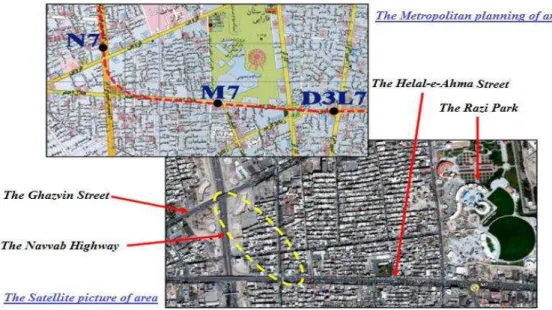
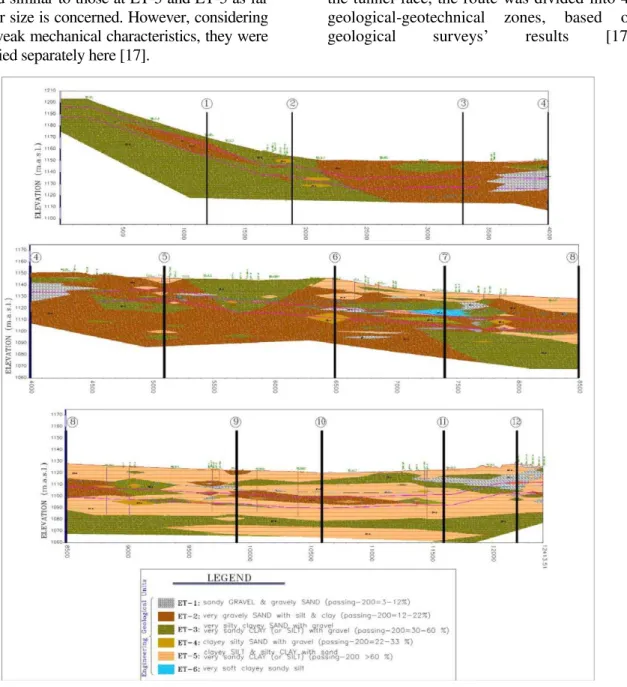
![Fig. 3. Geological profile of tunnel route for Tehran subway line 7 [17]](https://thumb-eu.123doks.com/thumbv2/123dok_br/16426826.195690/4.892.127.770.132.778/fig-geological-profile-tunnel-route-tehran-subway-line.webp)
![Fig. 4. Soil Particle size analysis for 1152-1367m distance range at geological unit ET-2 [20]](https://thumb-eu.123doks.com/thumbv2/123dok_br/16426826.195690/5.892.142.759.555.799/fig-soil-particle-size-analysis-distance-range-geological.webp)
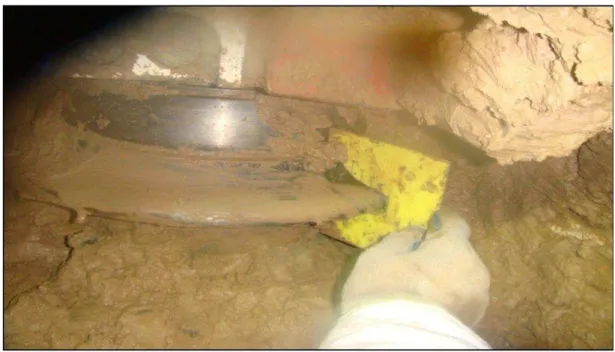
![Fig. 8. Thewes and Burger Clogging risk diagram for TBM due to the presence of clay minerals in the face tunnel [22]](https://thumb-eu.123doks.com/thumbv2/123dok_br/16426826.195690/7.892.224.671.134.384/fig-thewes-burger-clogging-diagram-presence-minerals-tunnel.webp)
![Fig. 11. Schematic view of foam nozzles on the EPB cutter head of Tehran subway line 7 tunnel [25]](https://thumb-eu.123doks.com/thumbv2/123dok_br/16426826.195690/8.892.160.740.784.1070/fig-schematic-view-nozzles-cutter-tehran-subway-tunnel.webp)
